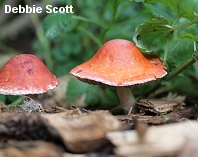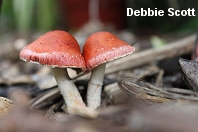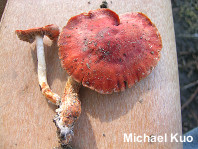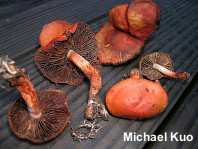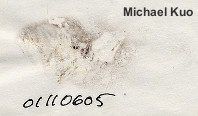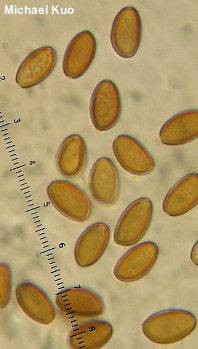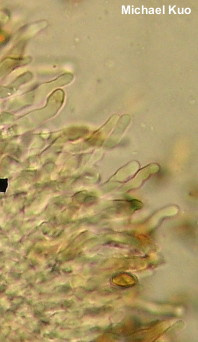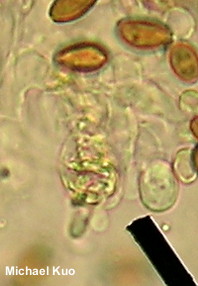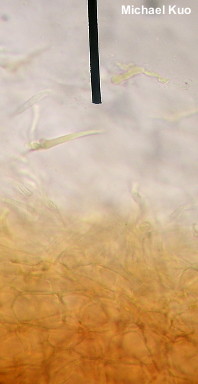| Major Groups > Gilled Mushrooms > Dark-Spored > Stropharioid Mushrooms > Leratiomyces ceres |

|
Leratiomyces ceres [ Basidiomycota > Agaricales > Strophariaceae > Leratiomyces. . . ] by Michael Kuo Leratiomyces ceres is found in woodchips or in gardens or lawns from northern coastal California to British Columbia. It appears to be a landscaping "import" like Morchella rufobrunnea, but it's a little difficult to determine where the species came from. It is found with increasing regularity in Europe, but it is also known from Australia and New Zealand. The range, habitat, bright orange colors, and purplish brown spore print of Leratiomyces ceres are distinctive, but it is sometimes confused with Leratiomyces squamosus var. thraustus, which decomposes woody debris in hardwood and conifer forests (at least in North America) and has a slimier cap, as well as a sturdy, gracefully arched ring and a shaggy stem. Leratiomyces squamosus var. thraustus also differs microscopically (it lacks chrysocystidia). Leratiomyces ceres was called "Stropharia aurantiaca" until DNA studies began to break up the stropharioid mushrooms. A 2008 paper by Bridge and collaborators fionds support for two clearly defined groups within what used to be called "Stropharia": the Stropharia group (containing Stropharia aeruginosa, Stropharia hardii, Stropharia coronilla, and Stropharia rugosoannulata); and the Leratiomyces group (containing Leratiomyces ceres, Leratiomyces squamosus, Leratiomyces percevalii, Leratiomyces magnivelaris, and species of Weraroa). The rules of taxonomy require that the genus name Stropharia stay with the Stropharia aeruginosa group, since that is the type species of the genus; Spooner and collaborators arrived at Leratiomyces for the second group by following similar taxonomic rules. Leratiomyces ceres, according to Spooner and collaborators, was traditionally misidentified as a match for Stropharia aurantiaca (originally named Agaricus squamosus f. aurantiacus by Cooke in 1887)—but the mushroom Cooke described is actually Stropharia thrausta (now known as Leratiomyces squamosus var. thraustus), which has a more slender stem, lacks chrysocystidia, and appears in woods. Description: Ecology: Saprobic; growing scattered or gregariously in woodchips or in sawdust, lawns, gardens, and so on; fall through spring; coastal California to British Columbia. The illustrated and described collections are from California. Cap: 2–6.5 cm; convex, becoming broadly convex, broadly bell-shaped, or nearly flat; bald; sticky when fresh, but soon dry; reddish orange to brownish orange; when young adorned with white veil remnants along the margin; the margin not lined. Gills: Attached to the stem by a notch; close; short-gills frequent; pale yellow at first, later purplish gray to purple-black; with whitish to pale yellow edges when mature; sometimes developing reddish stains and spots. Stem: 3–5 cm long; up to 1 cm thick; equal; dry; with or without a ring zone; bald or finely hairy; whitish to yellowish, staining reddish orange with maturity; base often with whitish to yellowish mycelial threads; basal mycelium white. Flesh: Whitish; unchanging when sliced. Odor and Taste: Not distinctive. Spore Print: Dark purple-gray. Chemical Reactions: KOH on cap surface dark gray. Microscopic Features: Spores 10–14 x 6–8 µm; ellipsoid; with a large (1 µm) pore at one end; smooth; brown in KOH. Basidia 4-sterigmate. Cheilocystidia as leptocystidia; 25–40 x 5–7.5 µm; cylindric-flexuous to fusiform or somewhat irregular; smooth; thin-walled; hyaline or golden in KOH. Pleuro-chrysocystidia 35–50 x 10–15 µm; lageniform; thin-walled; smooth; hyaline, with a globular, yellowish-refractive inclusion in KOH; sometimes absent. Pileipellis a thin ixocutis of cylindric elements 5–10 µm wide, golden in KOH, smooth, clamped at septa; over a cellular subpellis. REFERENCES: (Cooke & Massee, 1888) Spooner & Bridge, 2008. (Stamets, 1978; Arora, 1986; Noordeloos, 1999; Trudell & Ammirati, 2009; Desjardin, Wood & Stevens, 2015; Siegel & Schwarz, 2016.) Herb. Kuo 01110605, 01151107. Thanks to Debbie Scott for in situ photos of Leratiomyces ceres. This site contains no information about the edibility or toxicity of mushrooms. |
© MushroomExpert.Com |
|
Cite this page as: Kuo, M. (2017, May). Leratiomyces ceres. Retrieved from the MushroomExpert.Com Web site: http://www.mushroomexpert.com/leratiomyces_ceres.html |
